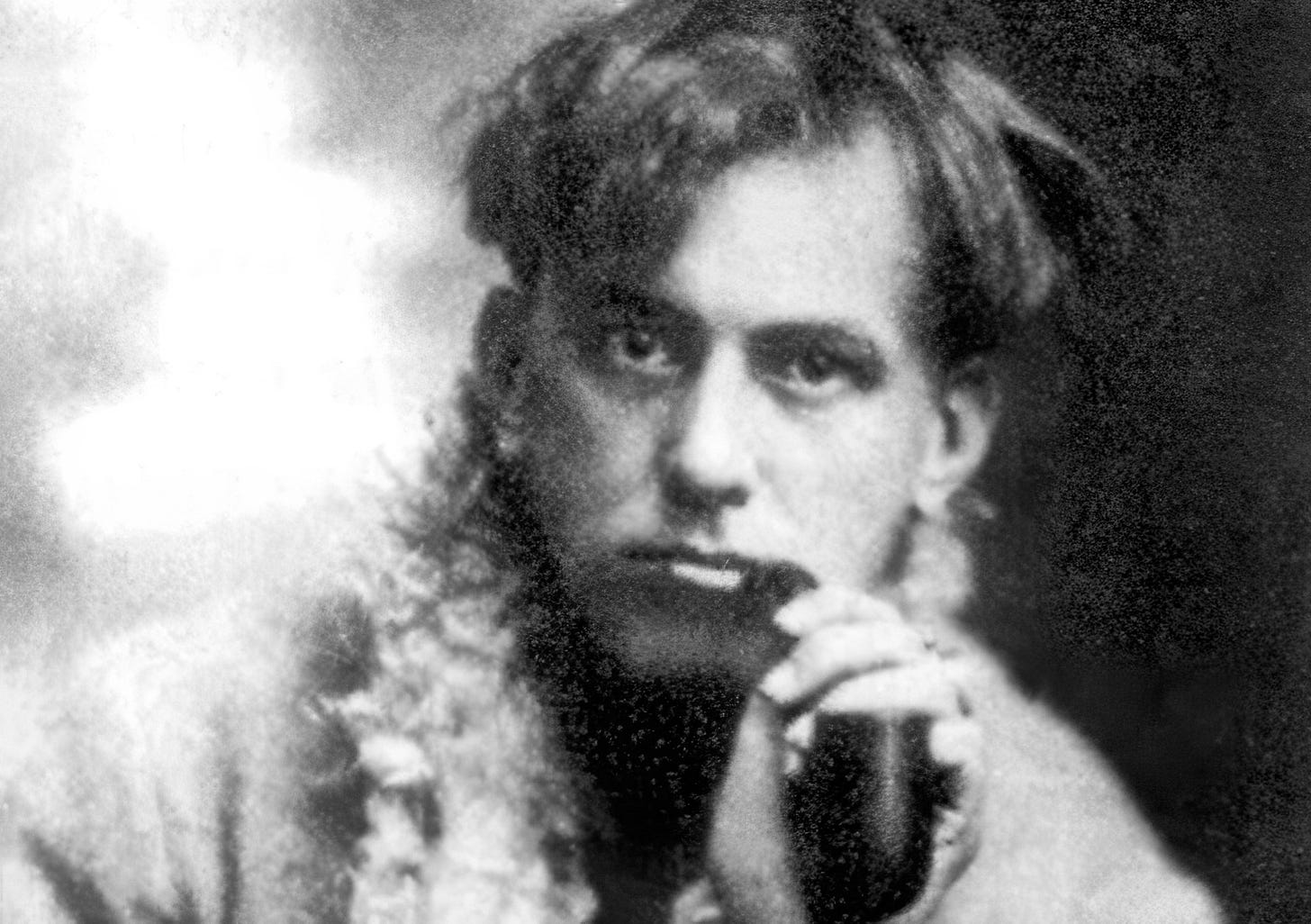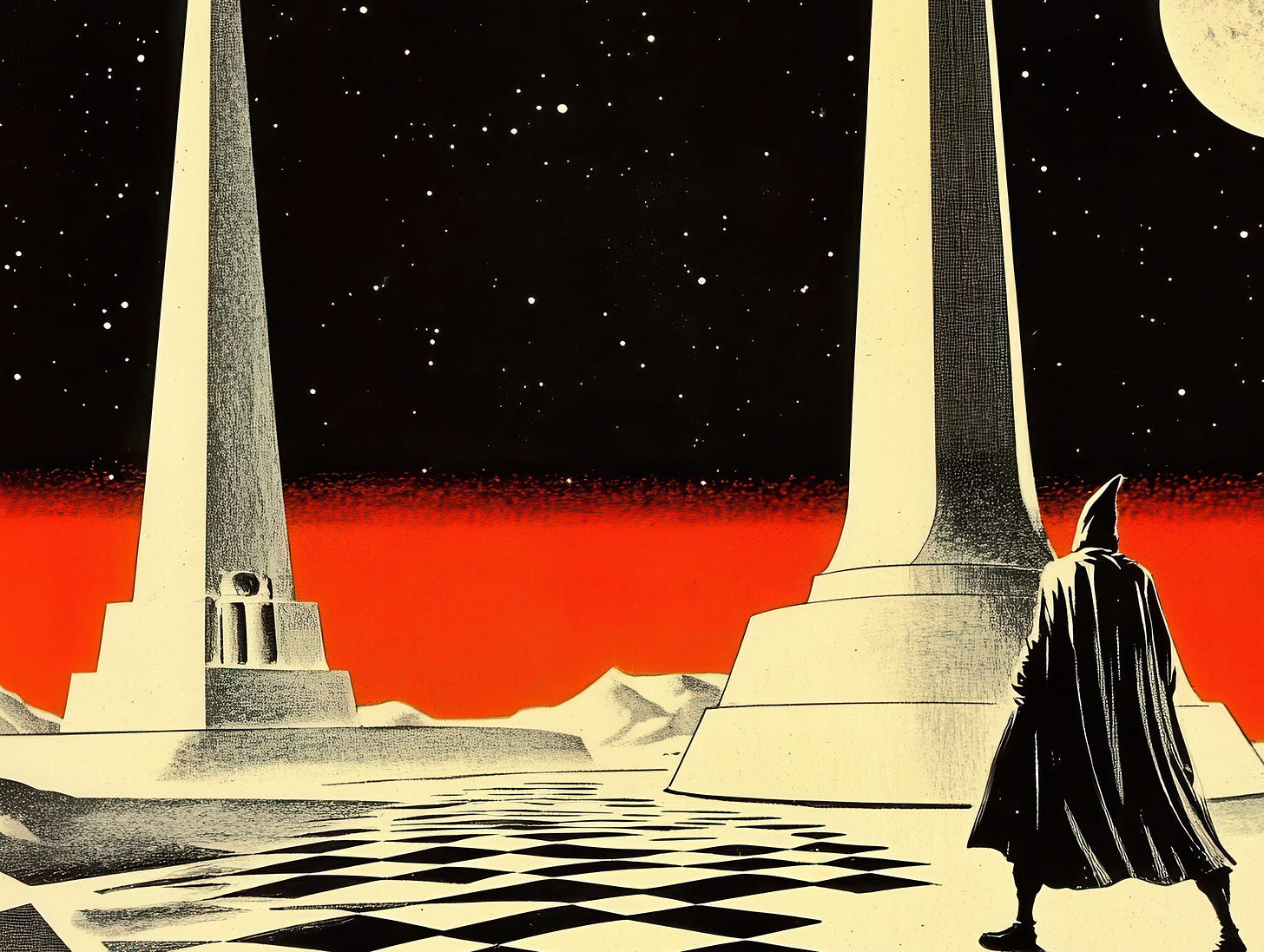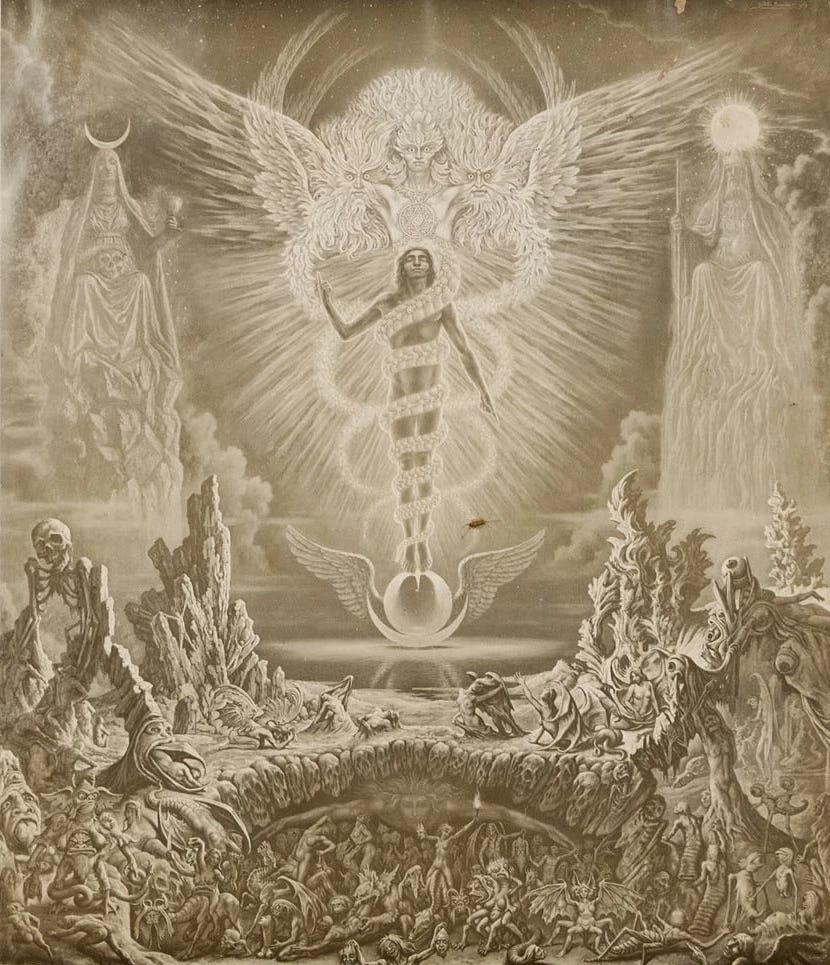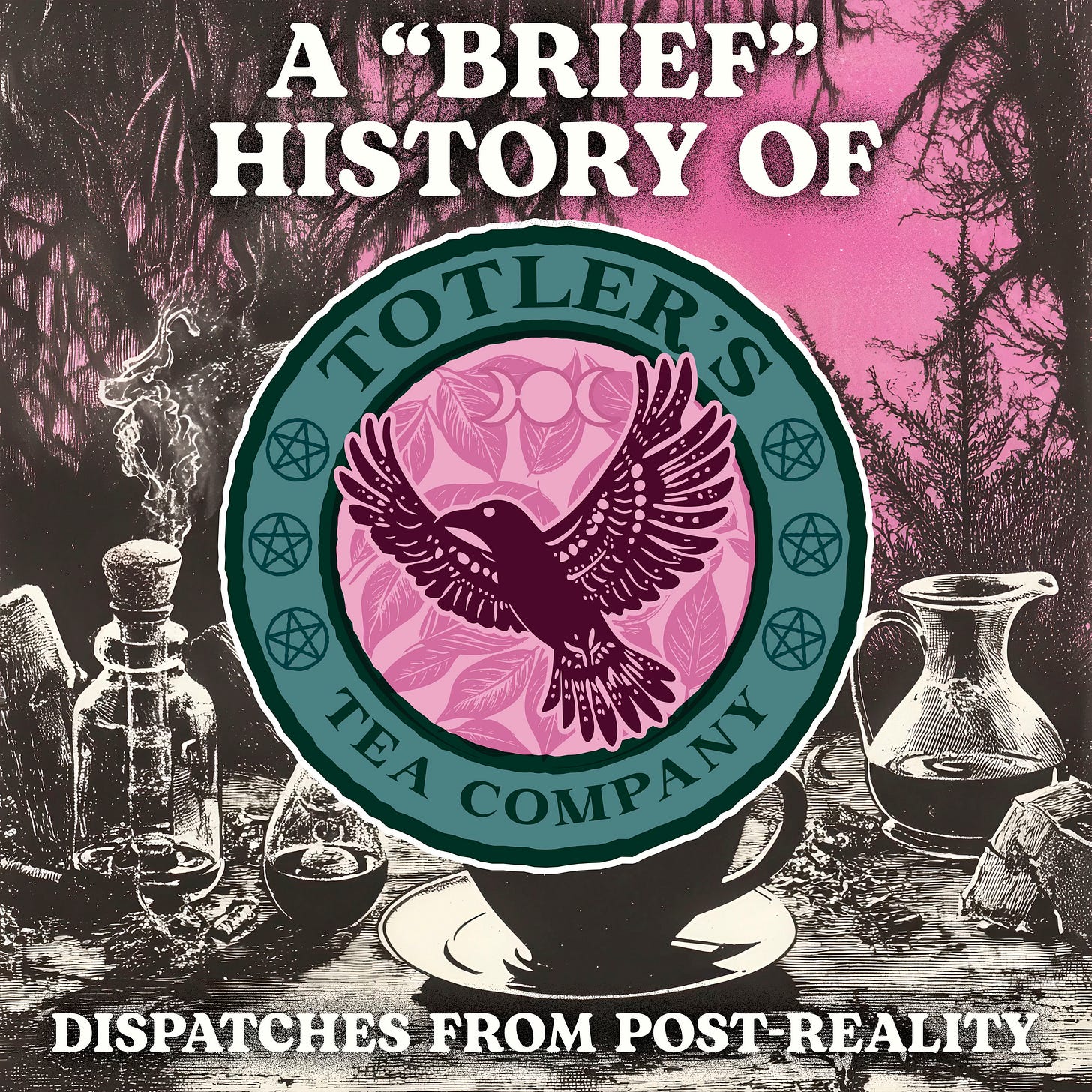On Liber B vel Magi
Sunday Deep Dive
Hey magical folks, I’m Nox Fortuna. Thank you for joining me on this 67,000mph ride through the cosmos. I’m talking about astrology, magick, the occult, weird stuff, high strangeness and occasional pop culture reviews. Join me each week for conversations on these topics and general camaraderie. Now, on to the show!
I’ve been thinking a lot lately about what defines living a magical life. Fitting today’s newsletter goes out on the day of the Sun, in the hour of Mercury on a Mercury cazimi.
Some days I don’t feel very magical at all. Some days I eat takeout and play Balatro for hours. I don’t feel that my wizard level diminishes on these days. So clearly, we shouldn’t classify ourselves based on the number of tarot cards we sling, or how many incense sticks we burned that day.
I think it helps to feel around the edges of what we think magick is. So, let’s start this with a series of questions:
Is magick natural or supernatural?
Is it different from regular old mundane forms of action?
Does magick happen in the past, present, or future? Or somewhere outside of time?
What does magical influence act on? What does it act with?
Does a Magician, in the broadest occult sense of the word, do anything at all outside the realm of natural cause and effect? Or do they take note of the currents of causality that exist in the world around them and act accordingly? Do they simply do nothing and let the wheel revolve around them?
To me, being a magician is a tapping in, a listening, and breathing with the universe. Your mileage may vary. It should, really.
A lot of fancy words have been written in the last several centuries about will and force (capitalize those words if you like), hierarchies, and domination of one being over another, but to me, they have always seemed to stem from a wrong way of thinking about magic and the world we share with all the visible and invisible forces around us. We are the many and the one, the individual and the all.
Everything is. Therein lies the mystery. That’s the fun of it. If we solved the mystery we’d be quite bored, wouldn’t we?
The joy is in the dance, not getting to the end of the dance, to paraphrase Alan Watts.
I’m pretty horrible at dancing but it’s a metaphor I think we can all understand. Here’s another one - magic is the song we sing along with the universe. Ceremony and ritual are the solo guitar riffs where we take the spotlight for a little bit, but it’s all part of the larger song.
You already know everything you need to know just by being a person in this world. The sunlight on the grass in the morning can teach you more than any guru ever could. The sound of the wind in the trees knows more about magic than I do.
Today I want to talk about some ideas from a man who thought he knew a lot about magic. Maybe he did have some good ideas but I’m sure we should all take it with a grain or several of salt.

Liber B vel Magi is a holy book of Thelema. The text is considered Class “A”, which, according to the Thelemic convention, “consists of books of which may be changed not so much as the style of a letter: that is, they represent the utterance of an Adept entirely beyond the criticism of even the Visible Head of the Organization.” In Liber 207: A Syllabus of the Official Instructions of the A∴A∴, it states:
LIBER I. LIBER B VEL MAGI. This is an account of the Grade of Magus, the highest grade which it is ever possible to manifest in any way whatever upon this plane. Or so it is said by the Masters of the Temple.
Not much has come down to us about the actual writing of this book. It seems to have been written in 1911, and it’s fairly short, at 23 lines. The structure of the document follows the typical numbered verse layout of many of Crowley’s other libri.
Crowley loved to start his writings by following the format of the Tree of Life. Usually, this begins not at Kether or the first sphere, but with the three veils of negative existence. Because of this, the text begins with verse 00. Apparently, 000 is super extra nothing, thus is the part of the text that doesn’t even really exist except in the silence of the moment before you begin reading it. Clever, huh? In 00. he states:
00. One is the Magus; twain His forces; four His weapons. These are the Seven Spirits of Unrighteousness; seven vultures of evil. Thus is the art and craft of the Magus but glamour. How shall He destroy Himself?
We see that using this particular map of what it is to be a Magus, there are specific attributes that are fundamental to a Magician. One is the Magus, but twain are his forces. The Magician sees and uses duality as forces and vehicles for their will, but knows that duality is only a construct that makes it easier to understand and move around in the universe.

The four weapons, of course, are the wand, the cup, the sword, and the pentacle representing the elemental aspects of the universe. Notice this is a rung lower down than the two forces mentioned before. Together, these are referred to as the Seven Spirits of Unrighteousness and labeled evil. Remember that we are still in the negative, where all things and ideas exist in a form that includes their opposite without any sort of duality or contradiction but doesn’t even exist yet at all really. They are the first swirling of nonexistence without form. Within this nonexistence we also find the ultimate goal stated plainly and the true quest of the Magician: How shall He destroy Himself?
Moving on to verse 0. we see:
Yet the Magus hath power upon the Mother both directly and through Love. And the Magus is Love, and bindeth together That and This in his conjuration.
Here is the first mention of the Mother. Usually, when Crowley capitalizes something, it’s a clue that there is a deeper meaning. Here, he is referencing the first He ה of the Tetragrammaton יהוה, the Primal Mother that corresponds to the third sphere of Binah on the Tree of Life. This and That are references to the internal and the external, the subjective and the objective.
In a way, the Magus is setting themselves up as the masculine/active force present in the Tetragrammaton, associated with the Father as yod י and the Son as the vav ו. The masculine force represents the active aspect of reality, whereas the so-called feminine represents the passive aspect. These terms are unnecessarily gendered, but we are working with a system that sprung out of the early 20th century, so please insert passive/active where applicable.
The Magus has power on the Mother directly and through Love. Love here specifically means the combination of opposites to create unity. Remember how the Magus is One, so connecting the Magus with Love is kind of just stating the same thing again to drive home the point. The Magician is a unifying force, and through this force, they are able to wield the Will to act upon the creative and manifesting aspect of the Mother.
Finally, we’ve reached the point of departure from nonexistence to existence itself as we go from verse 0. to verse 1.
1. In the beginning doth the Magus speak Truth, and send forth Illusion and Falsehood to enslave the soul. Yet therein is the Mystery of Redemption.
Crowley said the magus speaks Truth and Falsehood, illustrating the fact that anything we think, say, or believe is both true and false simultaneously in a fundamental sense. After all, how can a human describe the primal nature of anything from her limited standpoint down on Malkuth? Continuing on:
2. By His Wisdom made He the Worlds; the Word that is God is none other than He.
3. How then shall He end His speech with Silence? For He is Speech.
4. He is the First and the Last. How shall He cease to number Himself?
Wisdom is the title of the second sphere, Chokmah, which neatly ties into the numerology of it being the second verse.
Prompted by the odd wording and sentence structure, what if we don’t take it at the face value reading? Just for fun, let’s parse it a bit differently by reading “He” as the letter He ה, the 5th Hebrew character.
I’ll swap out the word He for ה and add some notations to make it a bit easier to understand. Let’s take another look at the passage again starting with verse 2:
By His Wisdom (Chokmah) made ה the Worlds (the Tree of Life and its constituent spheres); / the Word that is God is none other than ה. / How then shall ה end His (the Magician’s) speech with Silence? / For ה is Speech.
He is the Hebrew letter that has the gematria value of 5. The actual spelling of the letter He is הה. If we put 2 of them together, we would have two 5’s which of course add up to 10 indicating totality or wholeness (as in the totality of the 10 spheres on the Tree of Life). This corresponds to the idea of the Worlds in the verse. If you put the two 5’s side by side we get the number 55. Five is the number of Force and Will, so we can connect those ideas as fundamental to what the letter ה symbolizes. He is also the sound of breath and represents the vivifying life force.
If we take a closer look at the number 55, we find that the god name Ab Aima also has the value of 55. Ab Aima means Father and Mother and is somewhat key in understanding what Crowley is trying to say about the powers of the magus. According to the entry for the number 55 in Sepher Sapphires Volume 1:
55: Ab Aima, Father-Mother. Combines the titles of Chokmah and Binah which intimates that in Malkuth is the balanced manifestation of the male potency of wisdom and the female potency of understanding. Symbolized by the central figure in Key 21 (the tarot card), The World.
The very first words, “By His Wisdom” allude to the forces of the Father in Chokmah and connect that to the power of the Magus. As mentioned earlier, Wisdom is one of the titles of the sphere of Chokmah. Here the Magus is invoking the active energy of Chokmah and the manifesting powers of Binah symbolized by the letter He.
Next, we have “made ה the Worlds.” Reading into the symbolism, we could say that by Force and Will (He), the Magus harnesses the potential energy of the universe to manifest the Worlds. Notice here that the World gets a capital W and is plural. This implies that it’s not just the mundane matter around us, but our spiritual and internal world as well, and that there is more than one possible.
The next part reiterates this by saying “The Word that is God is none other than ה.”
Crowley talks about words a lot, but when he capitalizes it, he means something more occult and philosophical. An example of this would be the Word of the Aeon, a word that is meant to embody, define, and symbolize an entire aeon of time. So, this isn’t your regular word but something that has the power to create, define, and symbolize on a higher level.
The capital B Breath is used to create the capital W Worlds. This is the Breath that the letter He symbolizes, imbued with Force and Will. It’s the breath of universal life that vivifies each and everything in the universe.
So far in the story, we have the Magus (that’s you) using the active aspect of universal energy and then manifesting. We have established the dynamic flow of active and passive powers in creation and have called it Speech using the Breath as a universal vivifying principal.
What comes next is very interesting. The Word that is God is none other than He. Could this mean that the Word, the letter He, the Breath of Force, and Will and God are all something like each other, in a fundamental way?
Verse 3 continues:
How then shall He end His speech with Silence? For He is Speech.
We’ve already established the nature of He in this context, but now we’ve introduced the word Silence as well. You’d think that silence would be the exact opposite of speech, right? Of course, speech ends with silence, if you stop talking. Let’s take a look at the special version of Speech since it’s capitalized. If we look at it through the lens of gematria, we find that the word for Speech is דומה, and its value is 55. By this, we can see that even though speech and silence are opposite, they are metaphysically equivalent. The next verse says:
He is the First and the Last. How shall He cease to number Himself?
The phrase First and the Last indicates a totality, a whole. Alpha and Omega, beginning and end. Remember that the spelling of He is הה, which has a value of 10, the same as the number of spheres on the Tree of Life. How then shall the totality cease to number the Magus? What do we even do with this number soup?
We destroy it.
That was the goal stated right at the beginning of the document. To destroy something, you annihilate it with its opposite1. I strongly suspect that this whole He/ה thing has been a wordplay to get us to think about the active form of the Magus and the passive creative form of the letter ה as being two sides of the same coin that work in tandem to do magick, to create the World.
The text of Liber B vel Magi goes on for many more lines, but I won’t belabor the point I’ve already made. You can read it for yourself and expound further on the general concept. I think the important thing is that we are doing magick by taking part in the world. We are integrating events and experiences and transmuting them into creative actions to shape and create the world around us.
Further reading:
IAO131’s very in-depth breakdown of Liber B.
Hello reader, thank you for ending up on my newsletter. I truly appreciate you! Since you made it this far and must have some passing interest in all things odd, I want to introduce you to a new podcast called Dispatches from Post-Reality. There’s a discord, too! Yes, I am in the Discord. I am creating the art for the show episode covers and social media posts. It touches on some of the same esoteric subject matter you’ve come to love from this newsletter but with a decidedly funnier and much more casual tone.
This is often referred to as the action of Love in the Thelemic sense. That’s a whole other essay, though.






Wonderful analysis of this text. I think the substitution of the He for the Hebrew letter makes a lot of sense. What do you think about the last He that represents the era of Maat?